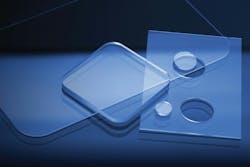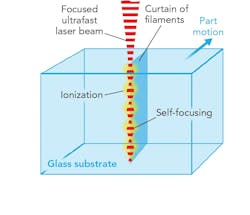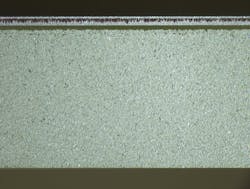GEORGE OULUNDSEN, JORIS VAN NUNEN, and MIKE LAHA
Mobile device displays increasingly use thinner glass, chemically strengthened glass, and multilayer construction (for example, glass plus LCDs, adhesives, or other plastic layers). In addition, screens with curved corners, contoured shapes, and cutouts are becoming more common. Many of the traditional mechanical and laser methods for glass cutting cannot adequately service these needs, and manufacturers are looking for technologies that will deliver higher precision, greater speed, shape flexibility (such as tight curves), reduced environmental impact, and lower overall cost. This article presents two laser processes, filamentation and carbon monoxide (CO) laser-based separation, that are emerging as important tools in meeting these production requirements.
Older technology doesn’t make the cut
The traditional mechanical technique for cutting glass involves first scribing the surface, and then applying a mechanical force to separate the pieces. Unfortunately, this approach produces microcracks, edge chips, and debris, necessitating post-processing (for example, grinding and polishing). For touchscreens, another common issue is reduced mechanical strength due to unacceptable levels of residual edge stress. All these limitations become even more acute with thinner (<1 mm) glasses, the advent of chemically strengthened glass (which can’t be readily cut using mechanical means), and the need to cut complex shapes.
There are two common laser-based approaches for glass cutting. The first is to use a carbon dioxide (CO2) laser, whose output is strongly absorbed by glass, for rapid heating. The glass is then thermally shocked through either air or water cooling, producing a continuous crack that is typically about 100 µm deep. A mechanical or laser separation step follows this. The biggest drawback of the CO2 laser is the inability to cut curves because of the line focus.
The second method utilizes a high-peak-power, pulsed nanosecond laser to ablate the glass. There are several approaches, depending upon substrate thickness and material type. Some completely cut through the substrate, while others make a scribe, using a subsequent breaking step. The main drawback of pulsed laser glass cutting is slow throughput speed.
SmartCleave: Photolytic process
So called “filamentation” cutting is an alternative process that was developed to address the limitations of prior methods. Coherent’s trade name for its patented version of this process is SmartCleave. Specifically, it enables high-speed cutting of curves and insets, without taper, into transparent and brittle materials from 50 µm to 10 mm in thickness (FIGURE 1). SmartCleave also delivers smooth surfaces, with edge chip sizes <5 μm. This yields a final bend strength that is measurably superior to mechanical processes, making it particularly attractive to touchscreen manufacturers.
SmartCleave utilizes an ultrashort pulse (<15 ps) laser, which self-focuses within the glass due to the Kerr optical effect. This self-focusing increases power density until, at a certain threshold, a low-density plasma is created in the material. This plasma lowers the material refractive index in the center of the beam path and causes the beam to defocus. If the beam focusing optics are properly configured, this focusing/defocusing effect can be balanced to repeat periodically and self-sustain. This forms a stable filament—a line of tiny voids—that extends over several millimeters in depth into the substrate. The typical filament diameter is in the range of 0.5 to 1 μm.
To achieve effectively zero-gap cutting or perforation lines, these laser-generated filaments are produced close to each other by a relative motion of the workpiece, creating a near-continuous curtain of voids through the glass (FIGURE 2). Motion speeds of 100 mm/s to 2 m/s can be achieved, depending on the material thickness and the desired cut geometry.A key factor in achieving the high focused power densities necessary for the practical implementation of SmartCleave cutting is the use of an ultrashort-pulse (USP; also known as ultrafast) laser, such as the Coherent HyperRapid NX, which provides so-called “burst mode” operation. Specifically, in burst mode, the laser provides a series of closely spaced pulses that act like a single super-pulse with a total pulse energy >700 µJ.
Layered substrates
An important recent development in SmartCleave technology is the advent of industrial femtosecond lasers with the requisite power/cost economics for glass cutting. This addresses the one potential limitation of picosecond lasers. Specifically, there is a growing need in medical, electronic, and display applications to cut layered or laminated substrates containing more than one material. A typical application is cutting glass that has a top coating of polyimide or PET, or cutting LCD displays that consist of two layers of glass with the LCD and adhesive sandwiched inside. In the past, this sometimes required first cleaving the glass with a picosecond laser, and then using another laser to scribe the other material(s).
Femtosecond lasers are proven to process nearly any material by conventional ablation. However, femtosecond lasers have not been employed in filamentation applications because of their higher cost and lower power as compared to picosecond lasers. The development of ultrafast lasers based on ytterbium-doped fiber (rather than the traditional titanium:sapphire) as the gain medium has yielded a new generation of sources that are more cost-effective, and also offer high average power.
The Coherent Monaco is an example of this new generation of industrial USP lasers that already offer average power as high as 60 W, with higher powers expected soon. Moreover, the Monaco pulse width can be software-tuned from ~350 fs to ~10 ps, enabling the output to be optimized for different filamentation conditions. And, critical for filamentation cutting, this laser supports burst mode operation (with a total burst energy of ~320 µJ).
Engineers in Coherent’s applications laboratory have demonstrated that, by careful process optimization, layered substrates with two or more dissimilar materials can be completely cut in a single pass, with superior edge quality, virtually no residual edge stress, and no heat-affected zone in the “delicate” layers (FIGURE 3).Separation anxiety
After SmartCleave, internal stress within chemically or thermally strengthened glasses typically causes spontaneous separation, without an additional step. But for glasses with a low coefficient of thermal expansion (CTE), this is not the case. And, low CTE borosilicate glass is now widely employed in displays.
In non-strengthened glasses, separation is achieved by applying mechanical or thermal energy along the filament contour. This causes the glass to separate in a very controlled manner along the stress imposed by the mechanical or thermal force. Most commonly, a CO2 laser is used in a thermal separation step.
However, the relatively high absorption of the CO2 output (in the 9–11 µm wavelength range) leads to some challenges. Specifically, most of the laser energy is absorbed near the glass surface where it can create high thermal stresses. This may result in some microcrack formation, which could create challenges in separating commonly used glasses, including soda-lime and some borosilicate types, particularly at the desired higher processing speeds.
An alternative method utilizes the carbon monoxide (CO) laser, with outputs in the 5–6 µm range, which penetrates far deeper into the glass. The result is much less localized, thermally induced surface stress at the surface. This provides less opportunity for microcrack formation and potentially faster glass separation processing speeds.
In addition, because the CO2 laser energy is strongly absorbed at the glass surface, a cooling jet (blown air or N2) is often used behind the laser beam spot to help facilitate the separation process for a high-quality result. But in the case of the CO laser, the deeper penetration makes the use of a cooling jet optional, or most commonly, not necessary at all. This enables a simpler equipment configuration and lower costs.
Conclusion
Lasers have provided an attractive alternative over mechanical methods for glass cutting for several years, particularly in demanding, high-precision applications, such as displays. Now, improvements in filamentation cutting, powered by a new generation of both industrial USP and CO lasers, promise to make laser cutting even more economical and advantageous, especially as display manufacturers move to more complex device construction and the increasing use of strengthened glass.
GEORGE OULUNDSEN (george.oulundsen@coherent.com) is director of product marketing, JORIS VAN NUNEN ([email protected]) is product marketing manager, and MIKE LAHA (mike.laha@coherent.com) is product line manager for ultrafast industrial lasers, all at Coherent, Santa Clara, CA; www.coherent.com.


